Frequently Asked Questions
Professional Paint Contractor
Serving The Pacific Northwest since 2005, SFW Painting has made a list of painting FAQs (frequently asked questions). This list includes both common and detailed questions about our major services including; interior painting, exterior painting, lead paint removal, historical home restoration, and commercial painting.
Exterior Painting
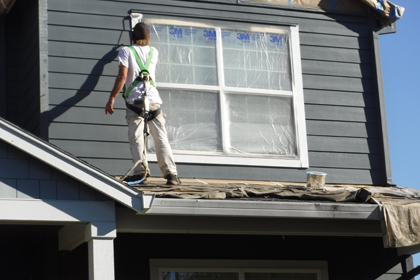
Yes, you have to paint the siding of your home after it is installed, except for vinyl. Using high-quality paint to paint your siding is an essential step to making it last and stay protected. SFW Construction uses pre-primed material and always makes sure to prime the material cuts, preparing the new siding for paint.
During the painting process, we manage all the prep, and this includes repairs. If you need repairs–like siding, dry rot, or anything else construction-related— we will step in seamlessly to keep your exterior painting project on schedule.
Often it isn’t easy to pick what color’s to paint the exterior of your home. Why? Because you have so many options to pick from, including the color, sheen, and brand. To help you decide, we offer various services, including color consultations, a visualizer, a seasonal color pallet, and Pinterest photos.
Once you narrow the colors down to three recommended paint samples, we finalize the color using a wet sample on all sides of your house before painting. Once you finalize the decision, we take paint and match it to the wet sample to ensure it’s the right color before painting your home.
You can paint your vinyl siding the exact same color or lighter color, that is generally safe. If you want to paint your house to a darker color you have to get an approved siding vinyl color from the manufacture and it’s still not guaranteed that it won’t warp. Changing to a darker color sometimes exposes the siding’s heat intolerance causing siding damage.
Preparing the exterior of your home before a painter arrives can help ensure your valuables will be kept in a safe place away from any crew member working. Common things customers move more we get out to the house include personal belongings, garden hose, decorations, movable plants, cars (if you can park them away 15 feet is the preference), patio furniture, lights, strings lights, and Christmas lights. If you have any other moveable objects or something you want to replace like your house numbers? Now would be a good time.
The purpose of the primer is to prepare different substrates to accept the topcoats of paint. Therefore, primers are designed to solve the challenges interior and exterior painters face. The challenges include sealing out moisture, resisting bleeding of stains and chemicals from inside the substrate, and locking down chalky surfaces.
When power washing your house you must be careful not to do any damage to the exterior of your home like getting water in your attic, water in between the siding and walls, siding damage, window damage, or remove any paint. In order to do that, and be protect your investment the common recommendation would be water, on low pressure, and do not use any bleach-based cleaner.
Interior Painting
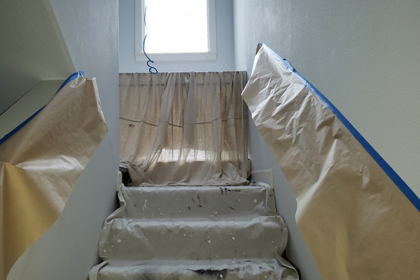
During the painting process, we manage all the prep, and this includes repairs. If you need repairs–like siding, dry rot, or anything else construction-related— we will step in seamlessly to keep your exterior painting project on schedule.
Kitchens and bathrooms are both high moisture areas, especially if your bathroom has a lack of ventilation and airflow. If your bathroom does not have a fan or window, paint failure is almost bound to happen. Common ways to combat high moisture areas and keep them dry include:
- Having good sources of ventilation like a high powered vent in bathrooms without a window. Opening windows in smaller bathrooms will also help to prevent moisture build-up
- Upgrading bathroom wall and ceiling paint to a high-grade latex enamel or paint
- Adding mildewcide to paint and primer to ensure mold blocking
Often customers want to know how many coats of paint to apply to the interior of their home.
- The first coat is primer specific. oil, latex, color blocking, odor-blocking, shellac primer should be applied if the paint is anything other than latex.
- If the current paint job is in good shape, generally two coats of paint will do the job. Unless, your new color is a brighter color, like yellow, red, blue, green. They generally require an additional coat (third coat).
How To Treat Mold And Mildew (ex. Shower)
- Clean it with bleach
- Prime it
- Add mildewcide additive to an interior premium paint (upgrade the paint if needed)
A common question we get asked is, “Once Painting Is Complete, Do You Put My House Back In Order?” Prior to the project starting, we ask that everything gets taken off the wall as our focus is mainly on cleaning and prepping the walls for painting. If needed we slide furniture and belongings out of the way to create a working space, which can fluctuate on a job depending on the layout. After we finish we put the area back the same way we found it. But, it’s the homeowner’s responsibility to refurnish and hang paintings and photos to their liking if different from the original layout.
With so many different primers to choose from, how do you know the difference between each one and which one is right for you?
- PVA – Drywall and Wallboard: Although any latex paint can be used over raw drywall, the first coat will only be used to seal and absorb, essentially a sacrificial coat. PVA is a cost-effective, the first coat that saves money and seals the wallboard to prepare two finish paint coats.
- Oil-based – Raw Wood /Stain-Blocking: Using oil over raw wood helps block the natural tannin bleed from wood. Oil is also used when going from a stained surface to a painted surface.
- Shellac: Shellac has been used for centuries to seal the wood and other surfaces. Perfect for interior paint jobs as shellac-based primers are possibly the best stain-blocking primers. They work well on severe water and smoke damage to walls and surfaces — they even seal in smells from smoke damage. They also are excellent at preventing normal water, rust, smoke stains, and wood tannins from bleeding through the new paint. They work well on wood, metal, plaster, and even plastic and are fast-drying and highly adhesive. They also can be used with both oil-based and latex paints.
- Bonding: When you’ve got a challenging surface—whether it’s a slick substrate or a compromised one—a bonding or adhesive primer is the go-to product of choice. Highly engineered, it’s a coating that promotes adhesion to the surface or existing coating and the new coat that you want to apply. A bonding primer is also used to encapsulate surfaces with lead paint present.
- Fiberglass: UMA’s advanced technology has both primer and adhesive-like properties. A quick-drying, white bonding primer/sealer that provides excellent adhesion, and it can be tinted. For tough-to-paint surfaces: glass, tile, Formica, metals, plastics, wood, and other construction materials including Kynar® and silicone polyester pre-coated siding.
Buying primer versus paint and primer all-in-one, what’s the difference? Priming is a general term. It’s not specific to one product; all it means is that depending on the substrate, it will prime the surface in preparation for a specific top coat.
Paint and primer all in one mean that the grade of paint may be high enough to get it done in one coat when covering a previously painted surface. It won’t work on raw surfaces such as Metallic surfaces (steel, sheet metal, etc.), raw wood (tannin Bleedthrough), water damage, smoke damage, or fiberglass. They all require surface-specific primers. It essentially only works over standard latex paints.
You should repaint your home any time you see paint failing, chipping, cracking, fading, or discoloration. Each house is different so we often recommend going through a small checklist every so often just to keep your house up to date. Some area’s to look at with attention to detail includes:
- Obvious wear and tear: (Near coat racks, high traffic, baseboards, high sunlight areas (fading), children’s bedrooms, high moisture, aesthetics (the color pallet and style) value of the home
- High traffic areas such as hallways, living rooms, and dining rooms start to show wear and tear
- Baseboards, crown molding, and other interior millwork that starts to separate from the wall (failed caulking)
- High moisture areas such as bathrooms and washrooms start to show signs of paint failure. Mold and Mildew, paint delamination, bubbling or peeling
- And visually, when interior colors become bland or outdated
Lead Paint Removal
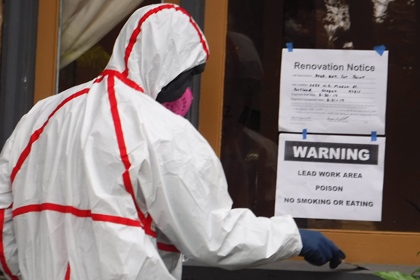
Whether you can use lead-free paint to paint over lead-based paint depends on if the house is fully encapsulated. Once the paint starts to deteriorate, the risk of lead dust spreading is probable and you should no longer paint over the lead paint. If the house is starting to show signs of paint failure, such as peeling and blistering, then the paint may be releasing lead dust influencing you to get the lead removed. Since we are dealing with a toxic chemical we must follow all EPA, RRP, and OSHA rules.
During the painting process, we manage all the prep, and this includes repairs. If you need repairs–like siding, dry rot, or anything else construction-related— we will step in seamlessly to keep your exterior painting project on schedule.
The lead test consists of a home swab test, a lab test, and an XRF Device.
Home Testing (swab): There are different types of home lead tests. Pens used to wipe across the wall and identify lead aren’t the most accurate. But can detect if enough lead is present to justify a lab or XRF test.
Lab testing (sample): Sending soil, paint, or water samples to a lab is a cost-effective way to narrow down lead presence in your home. However, preparing for large renovation projects, where lead exposure could be a more significant concern, we recommend hiring a professional. Either lead inspectors, assessors, or technicians to collect the samples of materials, paints, water, soil, and dust.
XRF (x-ray device): X-ray tube devices cost more to purchase than radioisotope devices, but because components of x-ray tube devices do not break down as rapidly, they do not need to be serviced as frequently as the radioisotope devices. In addition, because the x-ray tube device’s components do not suffer from half-life issues, they provide quicker, more constant readings.
If your house tested positive for lead, make sure to test both the inside and outside painted surfaces for lead-based paint. Often, if one side of your house tested positive, they both tend to have lead paint. In this case, if you have lead-based paint on both sides, you will want to identify which project is more important to mitigate the lead hazard and start there. You may have wanted to paint the outside first, but if you have your children and interior lead-based paint, that may take precedence over the exterior.
Once you have decided where to start removing or stabilizing the lead paint, contact a licensed lead contractor. Double-check online that they have up to date licensing as many advertise being lead-safe contractors online but oftentimes don’t renew their license. Once you have secured a contractor, you may need to make arrangements to move off-site depending on the size and scope of work sometimes. If the work area is isolated, the contractor can use plastic wall systems and work in an occupied home. But most times it will require a vacant work area. Onsite or offsite storage may also be required depending on the furniture and valuables needed for containment.
Lead renovation is a highly specialized process that is designed to offer a final solution to lead hazards. While RRP (renovation, repair, and painting) activities include slightly disturbing lead paint in conjunction with a larger scope of work like painting, siding, siding, installing windows, and light renovation.
Renovation, Repair, and Painting (RRP) Activities
- Projects are typically performed for aesthetic reasons or stop-gap control to minimize lead hazards.
- Service is NOT designed to permanently eliminate lead-based paint hazards
- Minor renovations and modifications
- Stabilizing failing paint in conjunction with a paint job
Often we get asked, “What is Lead-Based Paint?” Lead is a toxic metal that can cause serious health problems if it’s ingested or if dust containing lead is inhaled. Up until 1978, when federal regulations restricted the use of lead in household paint, lead was a common component in exterior and interior paints. If your home or structure was built before 1978, you will need to test for lead prior to contracting work. Lead could cause a range of health problems to the body, young children especially are at the greatest risk of lead poisoning which is why extra caution is taken when working with lead paint to avoid lead exposure.
Lead paint stopped being used on houses in 1978 when the EPA banned consumer use of paint containing lead. The lead from paint, including lead-contaminated dust, is one of the most common causes of lead poisoning.
Children are at the highest risk, as their growing bodies absorb more lead than adults, and their brains and nervous systems are more sensitive to lead’s damaging effects. Since children often put their hands and other objects in their mouths, it heightens the risk of ingesting lead dust or soil. Pregnant women are at risk, too, since lead exposure can carry to a developing baby.
Lead paint is dangerous because when it is absorbed into the body, either through inhaling fumes and dust of lead-contaminated objects, eating paint chips, or playing in lead-contaminated soil it can cause damage to the brain, organs, kidneys, nerves, and blood.
Historical Restorations
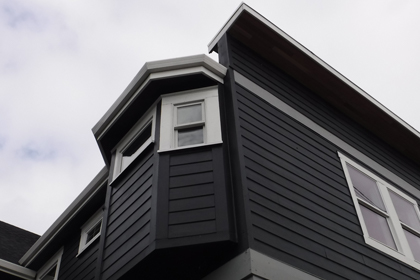
During the painting process, we manage all the prep, and this includes repairs. If you need repairs–like siding, dry rot, or anything else construction-related— we will step in seamlessly to keep your exterior painting project on schedule.
Many times customers ask, “Is it possible to keep the historical look of my home?” The answer is yes! If you hire a contractor who specializes in historical home restoration, that is. A professional contractor who works on older homes should have the skills to keep the historical look of your home. Skills include, but not limited to; lead paint removal experience, a designer to help find a historical template that works, and prep and paint experience. If your contractor does not have a designer and paints outside of a historical pallet it can affect the value of your home. Another way people end up losing money is by choosing only a paint contractor to work on their home, not one that can also conduct repairs.
If your older home needs a paint job, can a contractor help? The preferred contractor for homes built before 1980 is first and foremost going to be lead certified. In other words, most of the interior and exterior are going to have lead-based paint. Also, homes built before a certain time were not built to be waterproof, they were built to breathe. So knowing how to properly account for ventilation during construction is important.
If you have a historical home, hire a skilled contractor who knows the essential specialty repair services. Dealing with older homes vs. new homes is a big difference. Specifically, the amount of learning, training, and skill required is largely different. For example, older homes often require at least some carpentry work. So, our paint estimators will orchestrate a complete restoration to fit your needs. Whether it is siding repair, structural dry rot, crown molding, window repair, or special millwork details, we have an in-house option to get the job done.
Commercial Painting
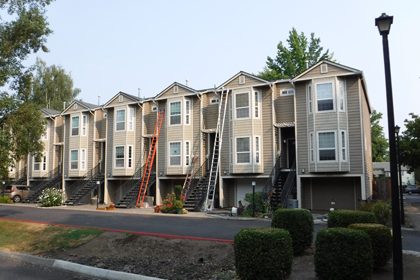
During the painting process, we manage all the prep, and this includes repairs. If you need repairs–like siding, dry rot, or anything else construction-related— we will step in seamlessly to keep your exterior painting project on schedule.
Fresh paint, whether latex or acrylic, should take 30-120 minutes to adhere to the surface, but it may take 30 days to cure fully. One way to help with the dry and cure times is to open windows and doors regularly during the 30-day period, so the paint does not stick together.
A paint system is a system that consists of sealers, primers, and paints that work together to produce a durable and beautiful finish.
The type of preparation needed to be complete before working on your property is dependent on the vision you have for your project. In other words, we tailor the needs of each homeowner to match the specifications for your project. We do this by providing various types of preparation services, including;
- Washing – New paint requires a clean canvas, dry, and with a firm base.
- Hand Scraping – Remove all loose and peeling paint with scrapers, knives, and steel brushes.
- Sanding – Sanding, depending on the substrate’s condition, is sometimes necessary to remove loose and peeling paint. In addition, sanding can help smooth out rough edges.
- Caulking and Sealing – We will remove any failing caulk before re-caulking. Ensuring we get all the vulnerable areas and where the caulk is missing or failing.
- Rust – We can scrape and wire brush surface rust until sound. After, we apply a rust-inhibiting primer before the top-coats.
SFW Painting will discuss what you hope to accomplish with your project and tailor the proposal to capture that vision.

